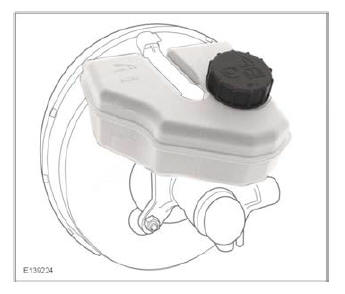Land Rover Defender: Checking the brake fluid level

Seek qualified assistance immediately if brake pedal travel is unusually long, or if there is any significant loss of brake fluid. Driving under such conditions could result in extended stopping distances or complete brake failure.

Brake fluid is highly toxic - keep containers sealed and out of the reach of children. If accidental consumption of fluid is suspected, seek medical attention immediately.

If the fluid comes into contact with the skin or eyes, rinse immediately with plenty of water.

Brake fluid is highly flammable. Do not allow brake fluid to come into contact with open flames, a hot engine, or other sources of ignition. A fire may result.

Do not drive the vehicle with the fluid level below the MIN mark.
If the quantity of fluid in the brake reservoir drops below the recommended level, a red warning lamp in the Instrument panel will illuminate.
Note: If the warning lamp illuminates while the vehicle is being driven, stop the vehicle, as soon as safety permits, by gently applying the brakes. Check and top up the fluid level, if necessary.
With the vehicle on level ground, check the fluid level at least every week. Check more frequently in high mileage or arduous operating conditions.

The driver's side under-bonnet cover must be removed to check the brake fluid level.
Check the brake fluid reservoir level. The level should be between the MIN and the MAX marks.
Note: The fluid level may drop slightly during normal use, as a result of brake pad wear. The fluid level should not be allowed to drop below the MIN mark.

